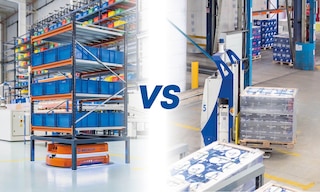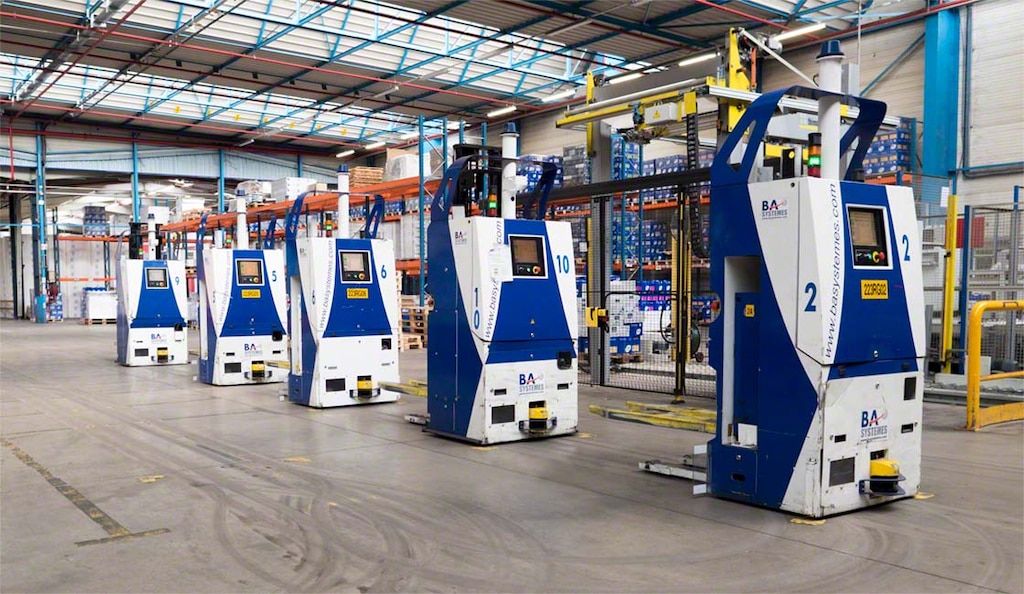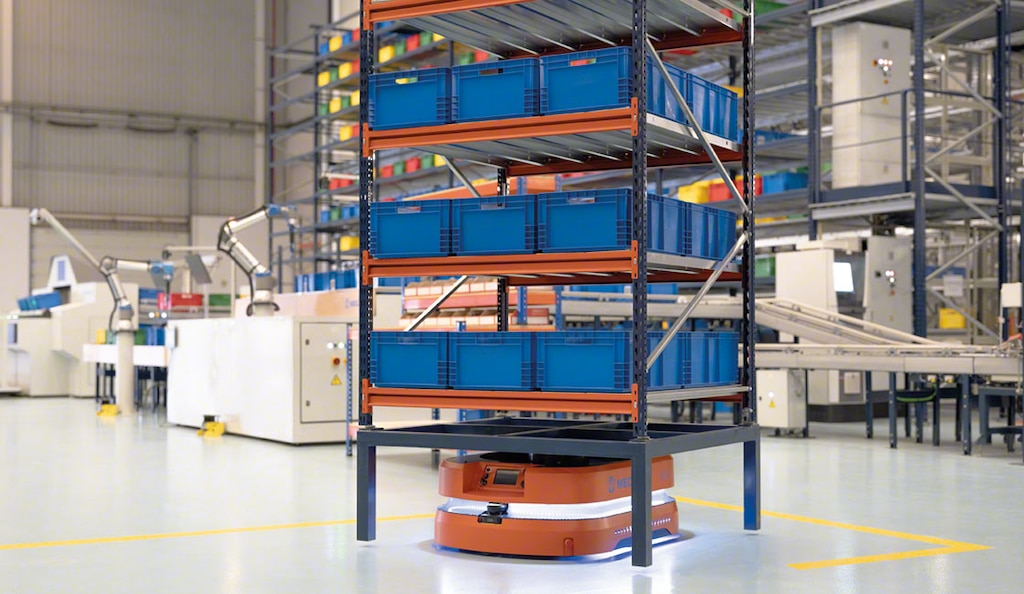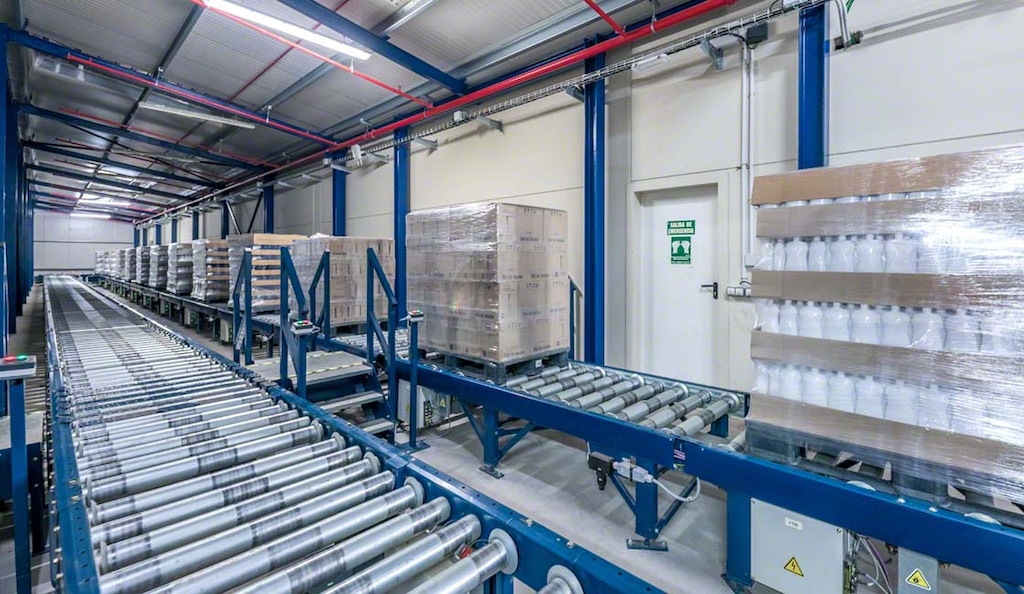
AMR vs. AGV: differences and which is better
Implementing automated goods transportation systems, such as AGVs (automatic guided vehicles) or AMRs (autonomous mobile robots), is an extremely efficient way of connecting the various areas of a warehouse or logistics or production center. Just like automatic conveyors, they are used in environments with continuous and repetitive material flows, thereby saving time, boosting productivity, and reducing accidents.
AGVs, automated vehicles that move in a guided way, have dominated the market over the past few decades. Nevertheless, in recent years, they’ve come up against a formidable competitor: AMRs, also known as autonomous intelligent vehicles (AIVs), which move and operate without preset routes.
But what are the differences between these two automated transportation systems? We break it all down in this post.
Navigation system: guided vs. autonomous
The main difference between AMRs and AGVs lies in the navigation system they use. While AGVs travel along a predefined route, AMRs adapt their routes according to the information they receive from their environment in real time.
This way, and with the help of technologies such as AI, AMRs can configure their route through the facility by means of layouts, without the need for rails, wires, or magnetic tape. And that’s why these mobile robots are called autonomous.
AGVs, meanwhile, incorporate minimum intelligence and move in a guided way along a closed circuit, obeying simple programming instructions.
Adaptability: closed circuit vs. open circuit
As AGVs move along a closed circuit, they’re highly efficient when traveling along a route that’s been defined in advance and doesn’t need to be changed. This means that, when they come across an object that obstructs their movement, such as a box or pallet, they stop immediately to avoid collision and wait for the object to be removed.

On the other hand, by using AI and their integrated cameras, sensors, and laser scanners, AMRs, can create an alternative route if met with an obstacle.
Both systems are extremely safe thanks to their numerous safety devices and accessories, such as laser sensors, cameras, protectors, etc.
Speed and load capacity: heavy vs. light goods
Both automated transportation systems can be personalized, adapted to the needs of each customer. As a rule, AMRs have capacities of between 0.11-2.2 tons, while AGVs can transport up to 5.5 tons.
As for speed of movement, this feature is similar in both transportation systems. The speed is also subject to the particular needs, the load, and the space for which the vehicles are used.

Other types of automated transportation systems
In addition to AMRs and AGVs, there are two other automated goods transportation systems on the market that are often found in warehouses with a high degree of automation and product movement:
- Conveyors. Conveyors consist of a set of rollers that carry the load and propel it along a circuit. The system is equipped with electric motors that move the unit loads in a safe, controlled way.
- Electrified monorails. This system is comprised of automated trolleys with two modes: aerial and floor-mounted. They move along an electrified rail.
Both automated transportation systems can be integrated with various elements (roller, chain, turntable, and vertical conveyors, among others) that combine or connect different areas in the facility, according to the load handling needs.
AGV vs. AMR: which is better?
All in all, the factors that really determine which automated transportation system is best are those having to do with the company’s objective, scope of application, and logistics planning. AGVs and AMRs both have their strengths and weaknesses, so depending on the application and environment, one of them will be the most appropriate.
In other words, if the project requires long trips with various routes that don’t always follow the same pattern, or the center has multiple obstacles, AMRs are the most suitable. An example of this is the new warehouse of Normagrup, the leading Spanish firm in the emergency lighting market. Our company equipped the center with an automated storage and retrieval system (AS/RS) connected to the production lines by four autonomous intelligent vehicles (AIVs). Every time a kit is assembled, Easy WMS notifies the software that runs the AMR for a vehicle to pick up the kit and bring it to the production line that requires it.
As for AGVs, they’re ideal when it comes to traveling long distances free of obstacles that are defined in advance and aren’t expected to be changed. This is the case of the project our company carried out for French paper manufacturer Clairefontaine. An aisle was opened up on one side of the warehouse where only the AGVs that move the goods from the production center to the warehouse can circulate.
Conveyors are especially useful for covering long distances, although they do occupy a fixed space. This is illustrated in the warehouse our company built for Venis (Porcelanosa Group), where an underground tunnel equipped with roller conveyors spanning over half a mile long connects the facility with the production plant.
Electrified monorails, meanwhile, are recommended when you need more agility. This can be seen in Sokpol’s juice warehouse in Poland, connected to the production center by an electrified monorail circuit. This transportation system reaches 328'/min and guarantees continuous goods flows.

Automated transportation system for every need
All automated transportation systems have their pros and cons, which you should take into account when setting up any kind of logistics facility. AGVs will help you to speed up internal transportation between areas where the path is free from obstacles, while AMRs will be very efficient at connecting zones with busier traffic and changing routes.
Are you considering automating product movements within your warehouse? If so, it’s best to seek the advice of a holistic provider like Interlake Mecalux. We have extensive experience in the design, manufacture, and installation of all types of intralogistics solutions. Our versatile range of AMRs covers diverse needs, from moving individual boxes to transporting picking shelves and pallets. Contact us without obligation to learn more about our automation solutions.
